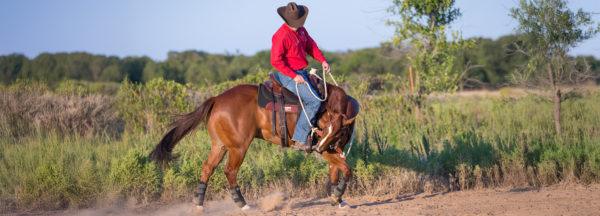Figuring Out the Cause of a Horse’s Head Tossing Issue


Clinton Anderson: Figuring Out the Cause of a Horse's Head Tossing Issue - Downunder Horsemanship
Two Types of Head Tossing
Clinton Anderson from Downunder Horsemanship has developed an effective method to train horses, regardless of their age, history, or any behavioral issues and past traumas. Join him on his weekly endeavors of tackling some of the most challenging situations with problem horses and with problem owners. This week, we watch as Clinton shows us how to figure out the cause of a horse’s head-tossing issue.
Clinton begins by telling us about the different types of head tossing that horse’s exhibit. A horse that constantly tosses his head has one of a few things going on. He might have a dental issue and the bit could be irritating him and making him feel uncomfortable. Before you do anything else, you should have his teeth looked at by an equine dentist and get any issues fixed. After you’ve ruled out a dental or health issue, you’re looking at a couple possible causes.
One type of tossing is where the horse exhibits behavior that makes him seem broken. He will pull on the bit every time you pick up on the reins instead of softening. This type of horse wants to root his nose out, throw his head up into the air, chomp on the bit, and just cause problems in general. This is the most common type of head-tossing problem that people approach Clinton with. Clinton explains that it’s because the horse is hard and stiff throughout his body and not soft and supple. The key to fixing the issue is getting your horse really light, both laterally and vertically, so that whenever you do pick up the reins, he honors and respects it.
Another type of head tossing is often caused by a blatant attitude problem. In this situation, you may be walking down a trail, enjoying the day, when your horse just throws his nose up in the air or shakes his head. If this happens, it’s important to take charge of the situation.
Clinton tells us that when he has a horse tossing his head due to an attitude problem, he bends the horse around in a circle and hustles his feet. Do it aggressively so that it feels uncomfortable to him and he won’t want to do it again. After the correction, put the horse on a loose rein and go down the trail. By putting the horse’s feet to work, you’ll notice the attitude drop and head tossing stops. It’s all about getting your horse to move his feet.
Another way to help your horse ditch the attitude is to do serpentines, rollbacks, or any other exercise you can think of. It doesn’t really matter what you do, as long as you’re making the horse hustle and you’re being effective about it. You need to act fast in response to a head toss so that the horse connects the behavior to the correction. If you wait too long, the reason for all of the extra work gets lost and he’s going to continue to toss his head. When you practice this a few times, your horse will figure out that shaking his head is associated with more work.
One thing that Clinton reminds us about is that some attitude problems are more serious than others. If the problem is fixed with the above measures, great. If it’s not, you’ve got some more homework to do. The key is returning back to the basics and putting miles under the horse’s feet. Get him moving his feet forwards, backwards, left and right. If you need help reviewing the fundamentals, or you just want to take your training to the next level, Clinton Anderson’s Downunder digital experience is a great place to start.
Clinton Anderson has devoted his life to creating the best training tools and videos available. Unfortunately, up until now it was nearly impossible to access the method when you’re on the go or at the barn. That’s why we’ve created three new ways to get the content you need at the price you want. Our Downunder Horsemanship app gives you access to your digital training kits and allows you to download videos and training content directly to your mobile device or view them on your computer. The Downunder Horsemanship app also offers over 100 hours of free, in-depth training content. You can also access all of the training material through three different levels by joining our No Worries Club. This mobile method allows for on-the-go training both in the roundpen and out on the trail. It’s the key to getting the most out of your partnership with your horse.
To learn more about the Clinton Anderson training method, become a member of the No Worries Club, or to get information on any of the products seen on our show, head over to our homepage and download the Downunder Horsemanship app today!
Want To Learn More? SIGN UP FOR OUR LOYALTY PROGRAM
Master your horsemanship training through Clinton’s step-by-step method videos by joining the No Worries Club today. Becoming a club member ensures you get VIP pricing on all of Clinton’s must-have training tools and resources. Plus, you’ll enjoy all the phenomenal benefits that come with club membership!


